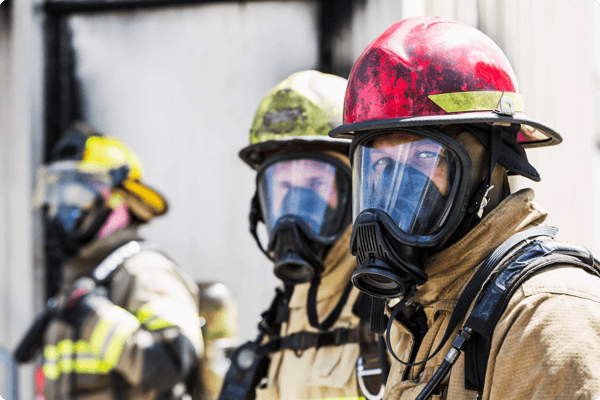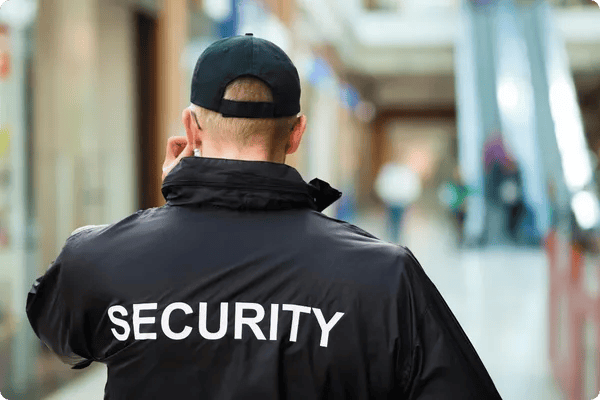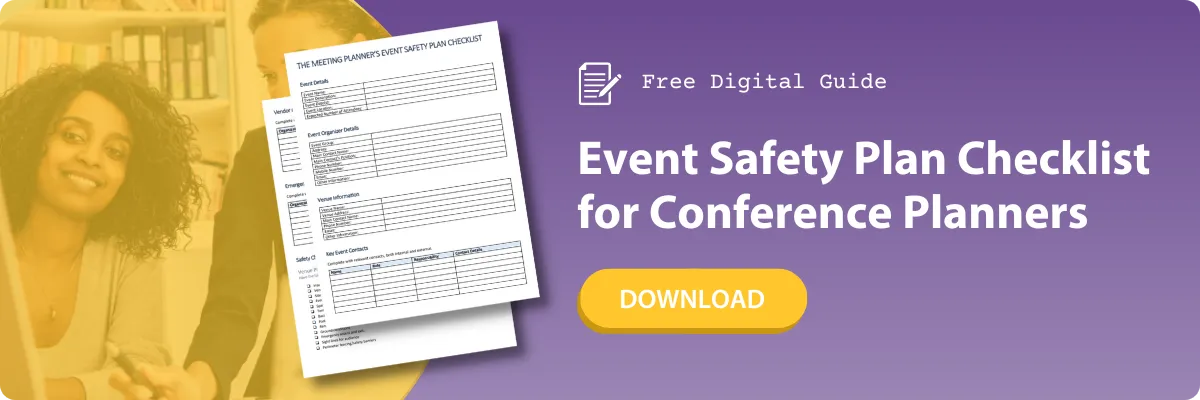When it comes to hosting safe meetings, event professionals have many emergency preparedness questions to answer:
- In an emergency, what should event management teams do?
- Where should conference attendees, exhibitors, and event staff go?
- What are the best ways to evacuate the event venue or expo hall?
- Where should occupants go for shelter in place?
- When should police and emergency personnel be contacted?
Creating a special event emergency action plan can help event professionals know when and how to act during unanticipated scenarios. Time is of the essence in any emergency, so read on to discover how a special event emergency action plan can help you manage potential risks and hazards associated with hosting a special event.
Emergency Action Plans for Events: What are they?
An emergency action plan (EAP) is a formally written document that identifies potential emergency conditions at events and creates procedures to minimize or prevent loss.
Emergency action plans help event organizers ensure the safety of every attendee, exhibitor, vendor, and staff member. They provide detail on how to greatly reduce injuries and prevent property damage in case of an unplanned situation like a fire, natural gas leak, life-threatening situation, violent incident, medical emergency, or other scenarios.

How Crisis Management Benefits Event Professionals
Most event planners would agree that safety and security are top priorities for any meeting they host. It is a planner’s duty to ensure that people are safe, operations are secure, and environments are kept clean and sanitary.
No safety strategy is complete without an emergency response plan that protects people, property, and assets from harm at your event.
Benefits of emergency preparedness planning for events include the following:
1. Reduce the risk of loss of life and property resulting from an emergency.They include carefully written instructions that help manage your response to personal injuries, violent actions, severe weather, natural disasters, and hazard-related situations. |
|
2. Identify conditions that could lead to site-related disasters.Just like an event risk assessment can help you identify potential risks and hazards, an emergency action plan describes how to respond to hazards and keep everyone safe in the process. |
|
3. Help people initiate appropriate emergency measures when needed.The confusion of an emergency can quickly make a bad situation worse, putting lives at risk. It’s better to know how to respond before a situation occurs. |
|
4. Increase safety and promote teamwork among stakeholders.Creating a planning team, assigning tasks, and electing leaders is essential to instilling confidence in your team members and coordinating safe meeting efforts before any special event. |
|
5. Establish favorable relationships with local law enforcement and emergency personnel.These organizations will appreciate the time and effort you put into creating a preemptive plan that communicates important safety-related details of your event. |
Conferences, expos, seminars, trade shows, and other public events should have an emergency response plan in place. Ready to start creating an emergency action plan that works? Keep reading to find our best tips and tricks for getting started.
Create an Emergency Preparedness Plan for Meetings and Events
Creating an emergency action plan is a sizable job. If you’re unsure of where to begin, follow these steps to get your team on the right path to hosting a safe event.
1. Write an emergency action plan statement of purpose.
Every emergency action plan should start with a statement of purpose. This tells stakeholders how and when the document is intended to be used. You can custom-tailor your statement of purpose to your unique event. A sample emergency action plan statement of purpose is as follows:
- “The purpose of this Emergency Action Plan (EAP) is to safeguard lives, reduce risks and hazards, mitigate loss and protect property during [event name] in the event of a major emergency.”
2. Compose a brief description of your event.
In an event planning emergency preparedness guide, an event description gives stakeholders a general overview and what to expect. Information to include in your event description is as follows:
- Event name
- Event date(s)
- Location of event
- Expected number of attendees (I.e. # of adults, # of children)
- Expected operating hours of the event
- Description of activities taking place at the venue
- Specification of food and/or alcohol being served
Don't forget to include a definitions section to help readers understand the terminology of your emergency action plan. For example, how does your team define a risk, a hazard, an emergency, a disaster, a major emergency response, a non-emergency response, etc.? This way, there is little room for misinterpretation among stakeholders.

3. Format an emergency contact information chart.
An emergency contact information chart is a hierarchy for notification in an emergency. It includes who is to be notified, by whom, and in what situation. This chart should be prominently displayed in your document (ideally on the first page of the emergency action plan).
Here, you can develop procedures to ensure the timely notification of persons responsible for taking emergency actions. Keep procedures brief and summarize the following information:
- Contact information for fire, police, ambulance, and emergency personnel
- Prioritized notification list of individuals and organizations
- A list of alternative contacts (include names, position titles, phone numbers, etc.)
Put someone in charge of coordinating emergency planning with public emergency services to stabilize incidents at your facility. Contact emergency medical services, security services, law enforcement officials, fire service officials, hospitals, emergency management officials, and others as appropriate.
4. Designate roles and responsibilities for emergency response procedures.
When it comes to emergency planning, it’s important to designate who is responsible for which tasks. Use this section of your emergency action plan to determine responsibilities associated with safety and security at your event. For instance, who is responsible for declaring an emergency under various circumstances? Who should initiate emergency actions as listed in the EAP?
Ensure all key event staff in the event safety plan are aware of the following information:- General information within your emergency preparedness plan
- Roles and responsibilities of other key event personnel
- Contact information for other key personnel
- Key assembly area locations in the expo hall or venue
- Emergency exit routes and doors
- Medical and emergency equipment locations, if provided
- Methods for communication with other key personnel
It can be helpful to cover all critical information like this in checklists and flowcharts. Not only will you condense information into a digestible format, but you'll also outline information for easy decision-making. Don’t forget to create a contact information section for all key personnel. Note which key personnel should act as liaisons with emergency responders.

5. Identify, evaluate, and classify event crisis situations.
Your event's emergency preparedness plan should cover which procedures to take for quick and reliable identification, evaluation, and classification of emergency conditions. More specifically, include the following in your emergency identification section:
- A list of situations or conditions that could lead to or indicate an emergency
- A brief description of how existing/potential emergencies will be identified and monitored
- A list of procedures for managing the conditions of an existing or potential emergency
- A variety of tools, aids, and instructions assessing the severity of a situation
- Designation of the person responsible for identifying and evaluating the emergency
Classify each risk and hazard according to its urgency so that appropriate action can be taken. Next, determine situations or triggering events that will initiate emergency actions. Reliable and timely recognition of emergency situations is imperative to any event’s success.
6. Identify preventative actions to be taken in an event emergency situation.
Once you have identified emergency situations that may occur at your event, it's time to identify how to respond to them. Your meeting's emergency preparedness plan should describe preventative actions your team members can take prior to the event, plus responsive actions to take following the development of emergency conditions.
Consider the following:
- How will emergency responders access the event site?
- How will communication be maintained during periods of adverse weather?
- What alternate means of communication can be used if one fails?
- What emergency supplies and resources do we need to be successful?
Preventative actions may also involve hiring security personnel, increasing event security measures, leveraging safety equipment, or establishing procedures for preventing emergency conditions from developing.

Your event’s crisis plan is complete. What’s next?
Remember, your emergency action plan won’t be useful if it’s written and filed away. Take the time to share it with your team and stakeholders, and ensure they know what to do in case of an emergency.
Conduct the following event safety tasks regularly:
- Review your plan on a scheduled basis.
- Make necessary improvements as needed.
- Facilitate exercises to practice your plan.
- Train personnel so they can fulfill their responsibilities.
Just as physical exercise allows you to perform physical tasks more easily, emergency procedure exercises allow your team to become acquainted with procedures before an actual emergency occurs. Don’t forget to conduct emergency drills and conduct a pre-event walk to ensure safety and security plans go off without a hitch!
Emergency Action Plan Templates and Tools for Special Events
Hungry for more knowledge? We thought so! Use the following articles and online resources to strengthen your event’s safety and security plan:
Top Event Safety and Security Resources:
- Risk Management Best Practices for Events: Use the tips within this guide to give your attendees and stakeholders peace of mind that your event is designed with safety in mind.
- Event Security Tips for Minimizing Risk: Find top tips for security teams on increasing security, promoting safety, and driving participation at your event.
Useful Emergency Preparedness Resources for Events:
- Emergency Action Plan Checklist: This online checklist by the Occupational Safety and Health Administration (OSHA) can help planners evaluate emergency-related tasks within venues.
- How to Develop an Emergency Response Plan: This article by Ready.gov outlines protective actions for life safety, as well as “10 Steps for Developing the Emergency Response Plan.”
- Design Guidance for Shelters and Safe Rooms: This manual by Federal Emergency Management Agency (FEMA) presents information on providing safe spaces in response to manmade hazards.




Submit a Comment